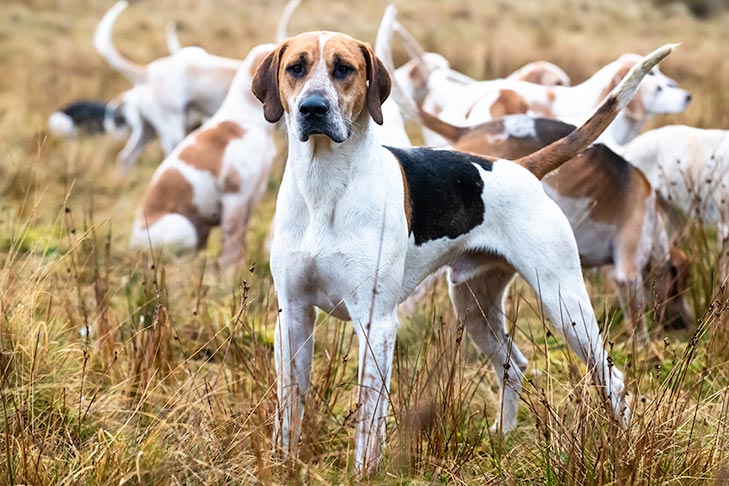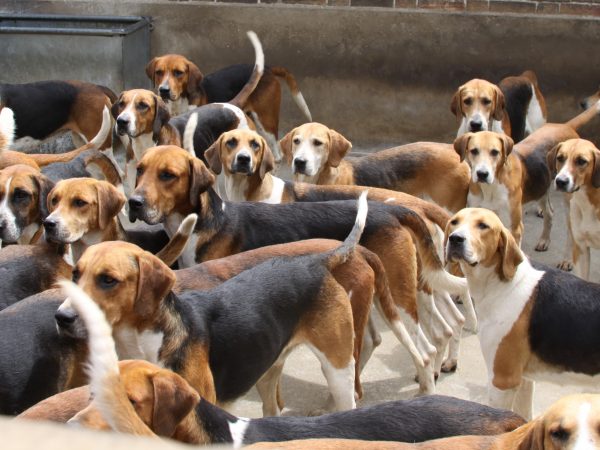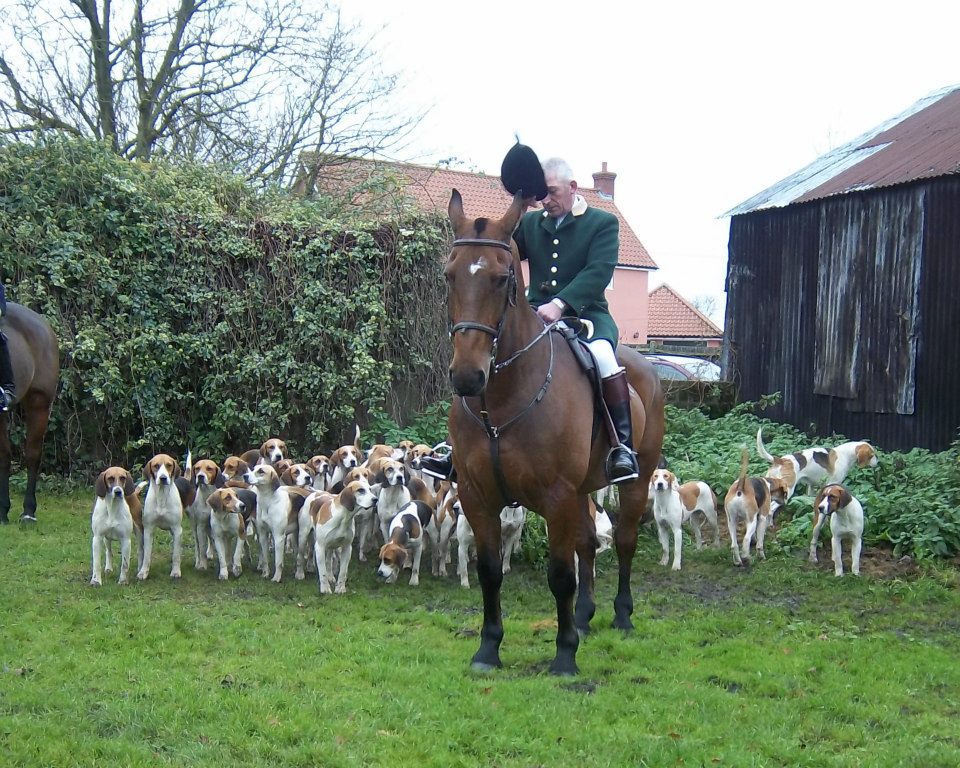
Judges Education Seminar for English Foxhounds & Harriers
Wednesday September 28th- Evening
Please sign up by adding the seminar to your cart and checking out ($0 cost) It will help us maintain a list of who is coming.
To register for English Foxhound of America Seminar – click here
To register for Harrier Club of America Seminar – click here
Ringside mentoring Thursday September 29th:
Foxhound National Specialty- AM
Harrier National Specialty- PM
Contacts
For Harriers contact Donna Smiley at Kingsburyharriers@outlook.com
For English Foxhound contact Andrea Bradford at tarabar@tds.net


Official Standard of the English Foxhound
Head: Should be of full size, but by no means heavy. Brow pronounced, but not high or sharp. There should be a good length and breadth, sufficient to give in a dog hound a girth in front of the ears of fully 16 inches. The nose should be long (4½ inches) and wide, with open nostrils.
Ears set on low and lying close to the cheeks. Most English hounds are “rounded” which means that about 1½ inches is taken off the end of the ear. The teeth must meet squarely, either a pig[1]mouth (overshot) or undershot being a disqualification.
Neck: Must be long and clean, without the slightest throatiness, not less than 10 inches from cranium to shoulder. It should taper nicely from shoulders to head, and the upper outline should be slightly convex. The Shoulders should be long and well clothed with muscle, without being heavy, especially at the points. They must be well sloped, and the true arm between the front and the elbow must be long and muscular, but free from fat or lumber. Chest and Back Ribs – The chest should girth over 31 inches in a 24-inch hound, and the back ribs must be very deep.
Back and Loin: Must both be very muscular, running into each other without any contraction between them. The couples must be wide, even to raggedness, and the topline of the back should be absolutely level, the stern well set on and carried gaily but not in any case curved over the back like a squirrel’s tail. The end should taper to a point and there should be a fringe of hair below. The hindquarters or propellers are required to be very strong, and as endurance is of even greater consequence than speed, straight stifles are preferred to those much bent as in a Greyhound. Elbows set quite straight, and neither turned in nor out are a sine qua non. They must be well let down by means of the long true arm above mentioned.
Legs and Feet: Every Master of Foxhounds insists on legs as straight as a post, and as strong; size of bone at the ankle being especially regarded as all important. The desire for straightness had a tendency to produce knuckling-over, which at one time was countenanced, but in recent years this defect has been eradicated by careful breeding and intelligent adjudication, and one sees very little of this trouble in the best modern Foxhounds. The bone cannot be too large, and the feet in all cases should be round and catlike, with well-developed knuckles and strong horn, which last is of the greatest importance.
Color and Coat: Not regarded as very important, so long as the former is a good “hound color,” and the latter is short, dense, hard, and glossy. Hound colors are black, tan, and white, or any combination of these three, also the various “pies” compounded of white and the color of the hare and badger, or yellow, or tan. The symmetry of the Foxhound is of the greatest importance, and what is known as “quality” is highly regarded by all good judges.
Scale of Points:
Head 5
Neck 10
Shoulders 10
Chest and back ribs 10
Back and loin 15
Hindquarters 10
Elbows 5
Legs and feet 20
Color and coat 5
Stern 5
Symmetry 5
Total 100
Disqualification: Pig-mouth (overshot) or undershot.
Approved 1935
Official Standard of the Harrier
General Appearance: Developed in England to hunt hare in packs, Harriers must have all the attributes of a scenting pack hound. They are very sturdily built with large bone for their size. They must be active, well balanced, full of strength and quality, in all ways appearing able to work tirelessly, no matter the terrain, for long periods. Running gear and scenting ability are particularly important features. The Harrier should, in fact, be a smaller version of the English Foxhound. Size, Proportion, Substance: Size – 19 to 21 inches for dogs and bitches, variation of one inch in either direction is acceptable. Proportion is off-square. The Harrier is slightly longer from point of shoulder to rump than from withers to ground. Substance – Solidly built, full of strength and quality. The breed has as much substance and bone as possible without being heavy or coarse.
Head: The head is in proportion to the overall dog. No part of the head should stand out relative to the other parts. The expression is gentle when relaxed, sensible yet alert when aroused. Eyes are medium size, set well apart, brown or hazel color in darker dogs, lighter hazel to yellow in lighter dogs, though darker to the entire animal, with good length and breadth and a bold forehead. The stop is moderately defined. The muzzle from stop to tip of nose is approximately the same length as the skull from stop to occiput. The muzzle is substantial with good depth, and the lips complete the square, clean look of the muzzle, without excess skin or flews. A good nose is essential. It must be wide, with well opened nostrils. Teeth meet in a scissors bite or they may be level. Overshot or undershot bites faulted to the degree of severity of colors are always desired. Ears are set on low and lie close to the cheeks, rounded at the tips. The skull is in proportion the misalignment.
Neck, Topline, Body: The neck is long and strong with no excess skin or throatiness, sweeping smoothly into the muscling of the forequarters. The topline is level. Back muscular with no dip behind the withers or roach over the loin. Body-Chest deep, extending to the elbows, with well sprung ribs that extend well back, providing plenty of heart and lung room. The ribs should not be so well sprung that they interfere with the free, efficient movement of the front assembly. The loin is short, wide and well muscled. The tail is long, set on high and carried up from 12 o’clock to 3 o’clock, depending on attitude. It tapers to a point with a brush of hair. The tail should not be curled over the back.
Forequarters: Moderate angulation, with long shoulders sloping into the muscles of the back, clean at the withers. The shoulders are well clothed with muscle without being excessively heavy or loaded, giving the impression of free, strong action. Elbows are set well away from the ribs, running parallel with the body and not turning outwards. Good straight legs with plenty of bone running well down to the toes, but not overburdened, inclined to knuckle over very slightly but not exaggerated in the slightest degree. Feet are round and catlike, with toes set close together turning slightly inwards. The pads are thick, well developed and strong.
Hindquarters: Angulation in balance with the front assembly, so that rear drive is in harmony with front reach. Well developed muscles, providing strength for long hours of work, are important. Endurance is more important than pure speed, and as such, the stifles are only moderately angulated. Feet point straight ahead, are round and catlike with toes set close together, and thick, well developed pads. Page 39 of 68
Coat: Short, dense, hard and glossy. Coat texture on the ears is finer than on the body. There is a brush of hair on the underside of the tail.
Color: Any color, not regarded as very important.
Gait: Perfect coordination between the front and hind legs. Reach and drive are consistent with the desired moderate angulation. Coming and going, the dog moves in a straight line, evidencing no sign of crabbing. A slight toeing-in of the front feet is acceptable. Clean movement coming and going is important, but not nearly as important as side gait, which is smooth, efficient and ground-covering.
Temperament: Outgoing and friendly, as a working pack breed, Harriers must be able to work in close contact with other hounds. Therefore, aggressiveness towards other dogs cannot be tolerated.
Approved December 13, 1988
Effective February 1, 1989